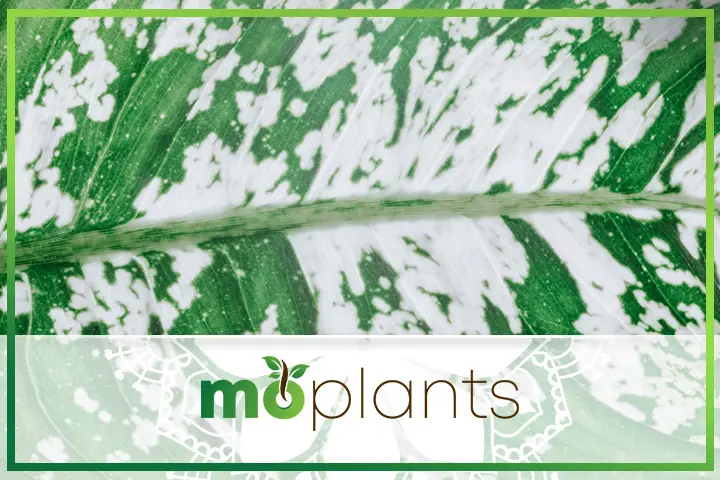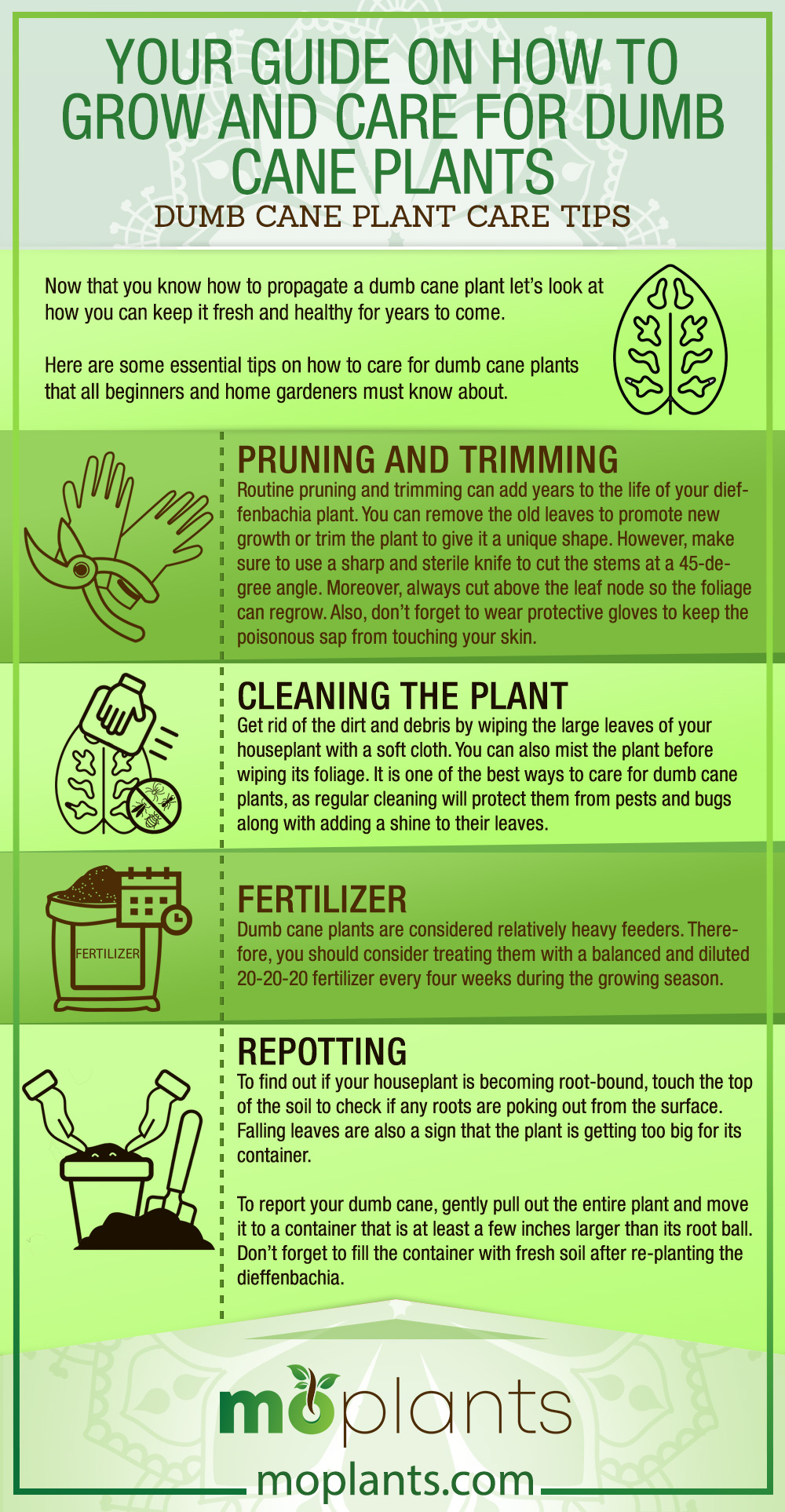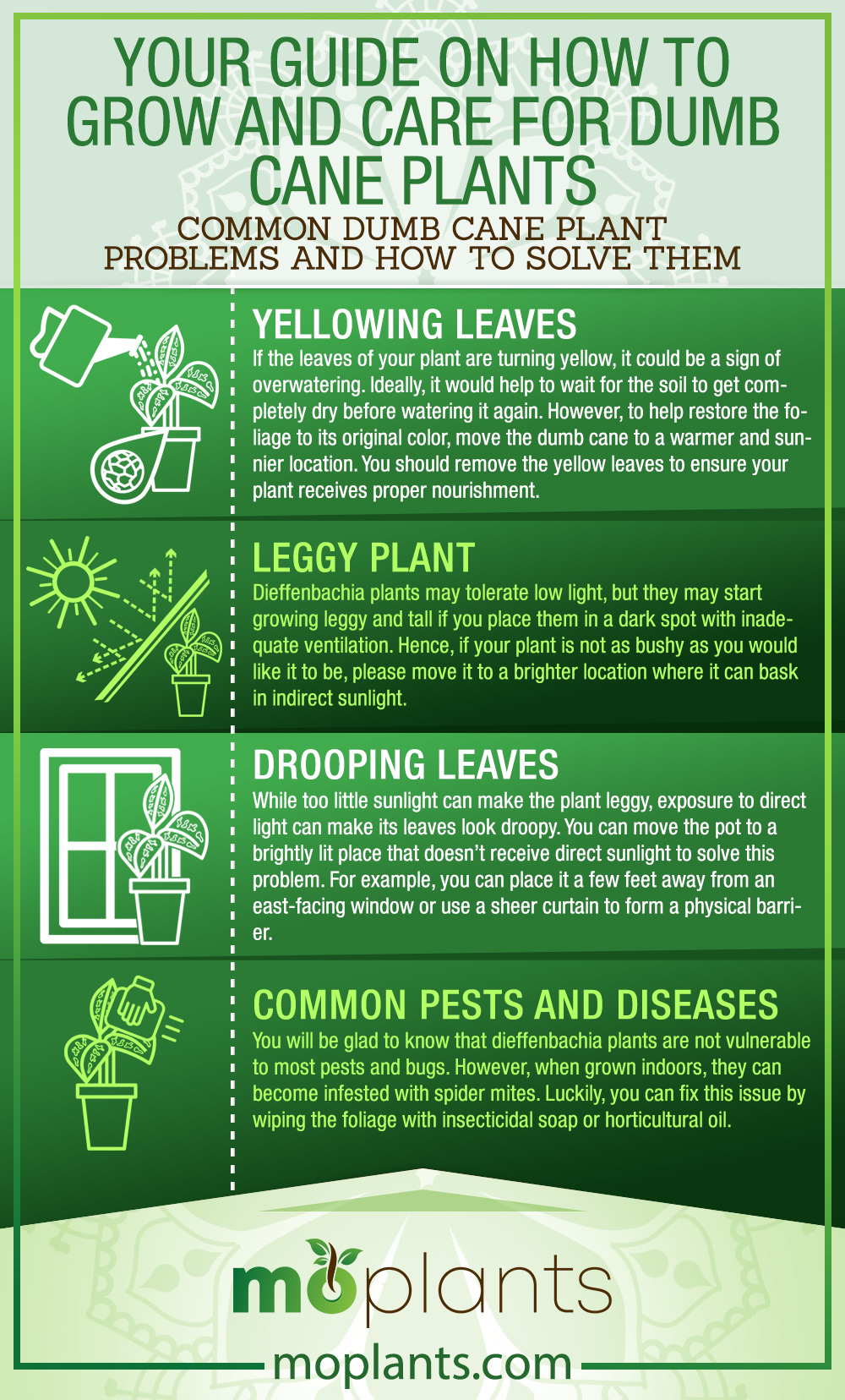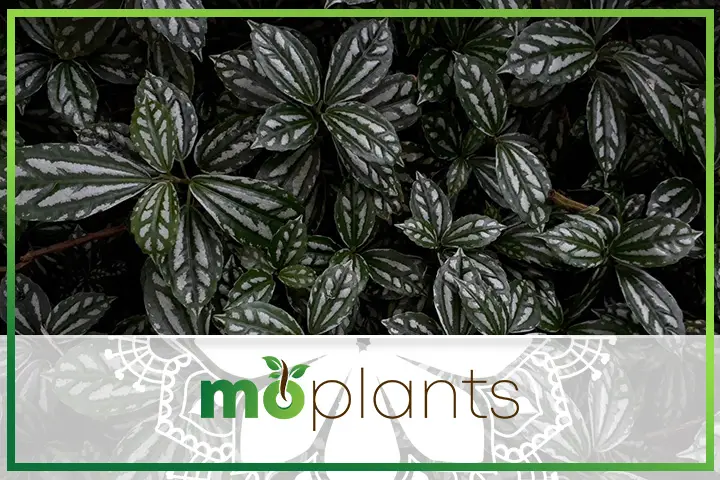The odd-sounding name of the dumb cane plant has nothing to do with its intelligence. A common décor element in houses and offices worldwide, this tropical houseplant is known for its lush and vibrant foliage that can break up the visual clutter and add some brightness to your space.
The dumb cane houseplant is highly adaptive to an average home environment, growing as tall as two feet when placed indoors. Under perfect conditions, it may produce small greenish-white flowers that are rather insignificant in appearance. Hence many home gardeners prefer to prune the bloom to ensure their beloved plant receives proper nourishment.
This popular houseplant is native to the Caribbean and South America, which means it prefers warm temperatures and high humidity. However, you can easily grow this exotic beauty anywhere in the world as long as it is not exposed to cold drafts or frost.
The plant gets its strange nickname from the toxic sap that contains calcium oxalate. It can cause extreme oral irritation and may even result in temporary loss of speech if ingested in large quantities. While it’s not toxic to touch, it is recommended to wear gloves while pruning its leaves. If that’s not possible, make sure to wash your hands thoroughly after tending to them.
Introduction: Dumb Cane Plant

The botanical name of the dumb cane plant is dieffenbachias. It is a herbaceous perennial belonging to the Araceae family and grows well in US hardiness zones 10 to 12.
The plant has large oblong leaves with pointy tips that feature a combination of green, yellow, and cream hues. In its natural habitat, a dumb cane houseplant can grow as tall as 10 feet, with leaves about 20 inches long and 10 inches wide. However, the plant typically grows up to half that height in an indoor environment.
It is also worth mentioning that dumb cane is a fast-growing plant.
The plant usually blooms during its growing season, producing a bug that is about 5 inches long. The leaves of the plants are usually yellow in the center, with cream-colored ribbons and spots appearing all over the surface. The edges of the leaves tend to be dark green, giving the foliage an exciting pattern and texture.
Apart from its busy and ornamental silhouette, the fan-favorite houseplant also boasts excellent air-purifying properties. It can remove toxins and pollutants from its surroundings, allowing you and your family to breathe cleaner and fresher air.
You can place this plant in your bedroom, living room, dining area, or hallway to add a natural element to your décor.
How to Grow Dumb Cane Plant
One of the best things about growing dieffenbachia is its low-maintenance nature. Despite its showy appearance, this popular houseplant pretty much grows on its own.
However, if you have never taken care of a plant before and feel a little uneasy about growing this tropical beauty indoors, we have put together some tips that you may find helpful.
Placement
The dumb cane plant thrives in bright and indirect light. In the summer and spring months, you can place it outdoors on your terrace or garden, where it can receive filtered sunlight for up to six hours a day. However, please note that younger leaves can turn brown and crispy due to prolonged exposure to the sun. So make sure to put your houseplant in a partially shaded area.
Meanwhile, if you want to keep this ornamental plant indoors, it would be best to place it about three feet away from the east or west-facing window in your home. You can also add a sheer curtain to ensure the foliage remains green and luscious.
Ideal Temperature
The dieffenbachia prefers temperatures between 65 and 80 degrees Fahrenheit. Once the temperature drops below 60 degrees, the tropical plant will begin losing its leaves. During the winter months, protect the plant from cold drafts as they may potentially kill it.
Humidity Level
The dumb cane plant is tolerant to most weather conditions. Typically, it flourishes in highly humid environments. However, it grows pretty well in an average home environment with about 50% to 60% humidity.
If you live in a drier region, consider placing a small humidifier near your dumb cane or place the pot on a tray of pebbles filled with water. As the moisture from the tray evaporates, it will dampen the foliage, giving it a healthy sheen.
Exposure to Light
The dieffenbachia plants fare well in low light conditions, making them an ideal companion for those who live in apartments or don’t have access to bright sunlight. Though if you want your houseplant to grow at a steady pace, make sure to place it in a sunny spot.
Moreover, rotate the plant every few weeks to ensure it grows in a symmetrical shape. Otherwise, the side facing the light will appear healthier and bushier than the other one.
Watering Frequency
Nothing can kill your houseplant more quickly than overwatering it.
Depending on the size of the dumb cane, watering it every once or twice a week is sufficient for its growth, particularly during the summer months. As the weather gets colder, cut back on watering the plant to prevent root rot.
The best way to determine if your plant needs water is to touch the top layer of the soil. If it feels dry to touch, water your dieffenbachia thoroughly. Allow the top two inches of the potting medium to dry completely before watering it next.
Potting Mix
This plant prefers slightly acidic soil with a pH level between 6.1 and 6.5. Using a well-drained and well-aerated potting mix is recommended to keep the roots from getting soggy and developing rot. You can buy a suitable potting medium for your dumb cane plant from a local nursery or create your own by mixing standard soil with perlite or coarse sand.
How to Propagate a Dumb Cane Plant
The easiest and most effective way to propagate a dumb cane plant is through its cuttings.
First, take a sharp knife and sterilize it. Next, cut a six to seven-inch cane section from a mature houseplant and place it horizontally in a tray with a few inches of fresh potting mix. Make sure your cane cutting is partly covered with the soil. You should spray the area with room-temperature water and keep the soil moist until the new plant begins to grow.
In an average home environment, it takes dumb cane houseplant about six to eight weeks to form roots. Consider moving it to a small pot with fresh soil once you can see tiny roots sprouting from the cutting. Ideally, you should keep the baby plant in a bright spot in your garden where it can receive filtered sunlight for about eight hours or so every day. Alternatively, you can wait for the plant to grow about two inches tall before planting it in a new medium.
Dumb Cane Plant Care Tips

Now that you know how to propagate a dumb cane plant let’s look at how you can keep it fresh and healthy for years to come.
Here are some essential tips on how to care for dumb cane plants that all beginners and home gardeners must know about.
Pruning and Trimming
Routine pruning and trimming can add years to the life of your dieffenbachia plant. You can remove the old leaves to promote new growth or trim the plant to give it a unique shape. However, make sure to use a sharp and sterile knife to cut the stems at a 45-degree angle. Moreover, always cut above the leaf node so the foliage can regrow. Also, don’t forget to wear protective gloves to keep the poisonous sap from touching your skin.
It would be best if you also refrained from pruning one-third of the leaves simultaneously, as it may shock the plant and result in excessive shedding.
Cleaning the Plant
Get rid of the dirt and debris by wiping the large leaves of your houseplant with a soft cloth. You can also mist the plant before wiping its foliage. It is one of the best ways to care for dumb cane plants, as regular cleaning will protect them from pests and bugs along with adding a shine to their leaves.
Fertilizer
Dumb cane plants are considered relatively heavy feeders. Therefore, you should consider treating them with a balanced and diluted 20-20-20 fertilizer every four weeks during the growing season.
Repotting
Due to their fast growth rate, the dieffenbachia plants require annual repotting.
To find out if your houseplant is becoming root-bound, touch the top of the soil to check if any roots are poking out from the surface. Falling leaves are also a sign that the plant is getting too big for its container.
To report your dumb cane, gently pull out the entire plant and move it to a container that is at least a few inches larger than its root ball. Don’t forget to fill the container with fresh soil after re-planting the dieffenbachia. In certain situations, the plant may take a few days to adjust to its new setting. During this time, keep the soil moist and refrain from moving the plant to a new location.
Infographic

Are Dumb Cane Plants Toxic?
As mentioned above, this plant is highly poisonous. Therefore, if you have young children or pets in your home, make sure to keep your dumb cane out of their reach. One way to go about this is to prune the lower leaves to give the plant a palm-like appearance.
Please remember that the poison from this plant can render a person mute for as long as two weeks.
Common Signs of Dumb Cane Poisoning
These are some of the most common signs of dumb cane poisoning among humans and animals alike.
If you notice any of these symptoms after coming in contact with the plant’s toxic sap, don’t hesitate to get in touch with a medical care provider or head to your nearest ER.
Common Dumb Cane Plant Problems and How to Solve Them
Here are some of the most common problems your dumb cane plant may experience and how you can troubleshoot them.
Yellowing Leaves
If the leaves of your plant are turning yellow, it could be a sign of overwatering. Ideally, it would help to wait for the soil to get completely dry before watering it again. However, to help restore the foliage to its original color, move the dumb cane to a warmer and sunnier location. You should remove the yellow leaves to ensure your plant receives proper nourishment.
Lack of nitrogen can also result in yellowing leaves. You can use a well-balanced fertilizer to see it can result in greener foliage.
Leggy Plant
Dieffenbachia plants may tolerate low light, but they may start growing leggy and tall if you place them in a dark spot with inadequate ventilation. Hence, if your plant is not as bushy as you would like it to be, please move it to a brighter location where it can bask in indirect sunlight.
Drooping Leaves
While too little sunlight can make the plant leggy, exposure to direct light can make its leaves look droopy. You can move the pot to a brightly lit place that doesn’t receive direct sunlight to solve this problem. For example, you can place it a few feet away from an east-facing window or use a sheer curtain to form a physical barrier.
Common Pests and Diseases
You will be glad to know that dieffenbachia plants are not vulnerable to most pests and bugs. However, when grown indoors, they can become infested with spider mites. Luckily, you can fix this issue by wiping the foliage with insecticidal soap or horticultural oil.
Infographic

Types of Dumb Cane Plants

Though dozens of dieffenbachia varieties are available at nurseries, these are the most popular ones among beginners.
Dieffenbachia Amoena
This is the most common plant that you may find in houses, offices, hotels, and hospitals, among other places. It is incredibly easy to grow and can get as tall as 6 feet in an indoor environment. Dieffenbachia Amoena has large, variegated leaves.
Dieffenbachia Seguine
Yet another popular dumb cane variety, Dieffenbachia Seguine is native to Brazil and is known for its distinctive ovate leaves that grow in clusters. The foliage is marked with green margins and cream-colored spots, giving it an element of interest. Typically, these plants can grow up to 10 feet under perfect conditions.
Dieffenbachia Maculate
The intensely variegated leaves of Dieffenbachia Maculate make it an ideal addition to any home. It has oblong leaves that are splattered with cream and white-colored spots. This plant is also known as Rudolf Roehrs.
Dumb Cane Plant FAQs
Here are some of the most frequently asked questions about the dumb cane plant.
Should one mist their dieffenbachia plant?
Since these plants prefer humid conditions, misting them every day or two can be an excellent way to keep the foliage healthy.
How do you make a dumb cane houseplant look fuller?
If the stem of your plant has grown too long and doesn’t have enough foliage, consider cutting the stem back at a 45-degree angle to encourage new growth. This is among the top tips to care for dumb cane plants.
Can you grow a dumb cane plant outdoors?
You can easily grow and propagate a dumb cane plant outdoors if you live in hardiness zones 10, 11, or 12.
To conclude, the dumb cane plant is easy to grow and care for. You can place it in any spot in your house that receives bright but filtered light. Also, make sure to water it once or twice every week and feed it every six to ten days.

